Convolutional hypercolumns in Python
If you are following some Machine Learning news, you certainly saw the work done by Ryan Dahl on Automatic Colorization (Hacker News comments, Reddit comments). This amazing work uses pixel hypercolumn information extracted from the VGG-16 network in order to colorize images. Samim also used the network to process Black & White video frames and produced the amazing video below:
https://www.youtube.com/watch?v=_MJU8VK2PI4
Colorizing Black&White Movies with Neural Networks (video by Samim, network by Ryan)
But how does this hypercolumns works ? How to extract them to use on such variety of pixel classification problems ? The main idea of this post is to use the VGG-16 pre-trained network together with Keras and Scikit-Learn in order to extract the pixel hypercolumns and take a superficial look at the information present on it. I’m writing this because I haven’t found anything in Python to do that and this may be really useful for others working on pixel classification, segmentation, etc.
Hypercolumns
Many algorithms using features from CNNs (Convolutional Neural Networks) usually use the last FC (fully-connected) layer features in order to extract information about certain input. However, the information in the last FC layer may be too coarse spatially to allow precise localization (due to sequences of maxpooling, etc.), on the other side, the first layers may be spatially precise but will lack semantic information. To get the best of both worlds, the authors of the hypercolumn paper define the hypercolumn of a pixel as the vector of activations of all CNN units “above” that pixel.
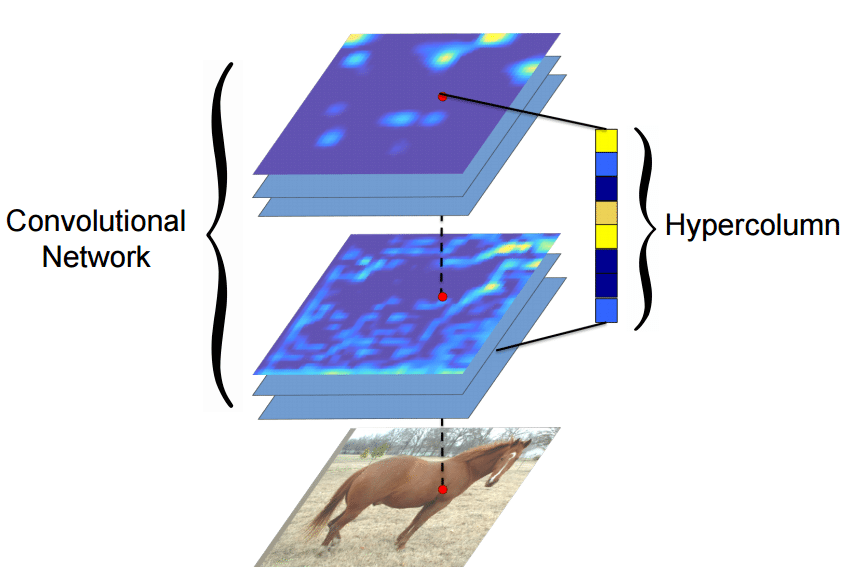
The first step on the extraction of the hypercolumns is to feed the image into the CNN (Convolutional Neural Network) and extract the feature map activations for each location of the image. The tricky part is when the feature maps are smaller than the input image, for instance after a pooling operation, the authors of the paper then do a bilinear upsampling of the feature map in order to keep the feature maps on the same size of the input. There are also the issue with the FC (fully-connected) layers, because you can’t isolate units semantically tied only to one pixel of the image, so the FC activations are seen as 1×1 feature maps, which means that all locations shares the same information regarding the FC part of the hypercolumn. All these activations are then concatenated to create the hypercolumn. For instance, if we take the VGG-16 architecture to use only the first 2 convolutional layers after the max pooling operations, we will have a hypercolumn with the size of:
64 filters (first conv layer before pooling)
+
128 filters (second conv layer before pooling ) = 192 features
This means that each pixel of the image will have a 192-dimension hypercolumn vector. This hypercolumn is really interesting because it will contain information about the first layers (where we have a lot of spatial information but little semantic) and also information about the final layers (with little spatial information and lots of semantics). Thus this hypercolumn will certainly help in a lot of pixel classification tasks such as the one mentioned earlier of automatic colorization, because each location hypercolumn carries the information about what this pixel semantically and spatially represents. This is also very helpful on segmentation tasks (you can see more about that on the original paper introducing the hypercolumn concept).
Everything sounds cool, but how do we extract hypercolumns in practice ?
VGG-16
Before being able to extract the hypercolumns, we’ll setup the VGG-16 pre-trained network, because you know, the price of a good GPU (I can’t even imagine many of them) here in Brazil is very expensive and I don’t want to sell my kidney to buy a GPU.

To setup a pretrained VGG-16 network on Keras, you’ll need to download the weights file from here (vgg16_weights.h5 file with approximately 500MB) and then setup the architecture and load the downloaded weights using Keras (more information about the weights file and architecture here):
from matplotlib import pyplot as plt
import theano
import cv2
import numpy as np
import scipy as sp
from keras.models import Sequential
from keras.layers.core import Flatten, Dense, Dropout
from keras.layers.convolutional import Convolution2D, MaxPooling2D
from keras.layers.convolutional import ZeroPadding2D
from keras.optimizers import SGD
from sklearn.manifold import TSNE
from sklearn import manifold
from sklearn import cluster
from sklearn.preprocessing import StandardScaler
def VGG_16(weights_path=None):
model = Sequential()
model.add(ZeroPadding2D((1,1),input_shape=(3,224,224)))
model.add(Convolution2D(64, 3, 3, activation='relu'))
model.add(ZeroPadding2D((1,1)))
model.add(Convolution2D(64, 3, 3, activation='relu'))
model.add(MaxPooling2D((2,2), stride=(2,2)))
model.add(ZeroPadding2D((1,1)))
model.add(Convolution2D(128, 3, 3, activation='relu'))
model.add(ZeroPadding2D((1,1)))
model.add(Convolution2D(128, 3, 3, activation='relu'))
model.add(MaxPooling2D((2,2), stride=(2,2)))
model.add(ZeroPadding2D((1,1)))
model.add(Convolution2D(256, 3, 3, activation='relu'))
model.add(ZeroPadding2D((1,1)))
model.add(Convolution2D(256, 3, 3, activation='relu'))
model.add(ZeroPadding2D((1,1)))
model.add(Convolution2D(256, 3, 3, activation='relu'))
model.add(MaxPooling2D((2,2), stride=(2,2)))
model.add(ZeroPadding2D((1,1)))
model.add(Convolution2D(512, 3, 3, activation='relu'))
model.add(ZeroPadding2D((1,1)))
model.add(Convolution2D(512, 3, 3, activation='relu'))
model.add(ZeroPadding2D((1,1)))
model.add(Convolution2D(512, 3, 3, activation='relu'))
model.add(MaxPooling2D((2,2), stride=(2,2)))
model.add(ZeroPadding2D((1,1)))
model.add(Convolution2D(512, 3, 3, activation='relu'))
model.add(ZeroPadding2D((1,1)))
model.add(Convolution2D(512, 3, 3, activation='relu'))
model.add(ZeroPadding2D((1,1)))
model.add(Convolution2D(512, 3, 3, activation='relu'))
model.add(MaxPooling2D((2,2), stride=(2,2)))
model.add(Flatten())
model.add(Dense(4096, activation='relu'))
model.add(Dropout(0.5))
model.add(Dense(4096, activation='relu'))
model.add(Dropout(0.5))
model.add(Dense(1000, activation='softmax'))
if weights_path:
model.load_weights(weights_path)
return model
As you can see, this is a very simple code to declare the VGG16 architecture and load the pre-trained weights (together with Python imports for the required packages). After that we’ll compile the Keras model:
model = VGG_16('vgg16_weights.h5')
sgd = SGD(lr=0.1, decay=1e-6, momentum=0.9, nesterov=True)
model.compile(optimizer=sgd, loss='categorical_crossentropy')
Now let’s test the network using an image:
im_original = cv2.resize(cv2.imread('madruga.jpg'), (224, 224))
im = im_original.transpose((2,0,1))
im = np.expand_dims(im, axis=0)
im_converted = cv2.cvtColor(im_original, cv2.COLOR_BGR2RGB)
plt.imshow(im_converted)
Image used
As we can see, we loaded the image, fixed the axes and then we can now feed the image into the VGG-16 to get the predictions:
out = model.predict(im) plt.plot(out.ravel())
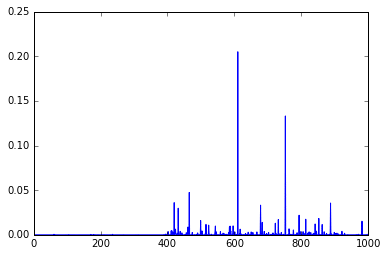
As you can see, these are the final activations of the softmax layer, the class with the “jersey, T-shirt, tee shirt” category.
Extracting arbitrary feature maps
Now, to extract the feature map activations, we’ll have to being able to extract feature maps from arbitrary convolutional layers of the network. We can do that by compiling a Theano function using the get_output() method of Keras, like in the example below:
get_feature = theano.function([model.layers[0].input], model.layers[3].get_output(train=False), allow_input_downcast=False) feat = get_feature(im) plt.imshow(feat[0][2])
Feature Map
In the example above, I’m compiling a Theano function to get the 3 layer (a convolutional layer) feature map and then showing only the 3rd feature map. Here we can see the intensity of the activations. If we get feature maps of the activations from the final layers, we can see that the extracted features are more abstract, like eyes, etc. Look at this example below from the 15th convolutional layer:
get_feature = theano.function([model.layers[0].input], model.layers[15].get_output(train=False), allow_input_downcast=False) feat = get_feature(im) plt.imshow(feat[0][13])
More semantic feature maps.
As you can see, this second feature map is extracting more abstract features. And you can also note that the image seems to be more stretched when compared with the feature we saw earlier, that is because the the first feature maps has 224×224 size and this one has 56×56 due to the downscaling operations of the layers before the convolutional layer, and that is why we lose a lot of spatial information.
Extracting hypercolumns
Now finally let’s extract the hypercolumns of arbitrary set of layers. To do that, we will define a function to extract these hypercolumns:
def extract_hypercolumn(model, layer_indexes, instance):
layers = [model.layers[li].get_output(train=False) for li in layer_indexes]
get_feature = theano.function([model.layers[0].input], layers,
allow_input_downcast=False)
feature_maps = get_feature(instance)
hypercolumns = []
for convmap in feature_maps:
for fmap in convmap[0]:
upscaled = sp.misc.imresize(fmap, size=(224, 224),
mode="F", interp='bilinear')
hypercolumns.append(upscaled)
return np.asarray(hypercolumns)
As we can see, this function will expect three parameters: the model itself, an list of layer indexes that will be used to extract the hypercolumn features and an image instance that will be used to extract the hypercolumns. Let’s now test the hypercolumn extraction for the first 2 convolutional layers:
layers_extract = [3, 8] hc = extract_hypercolumn(model, layers_extract, im)
That’s it, we extracted the hypercolumn vectors for each pixel. The shape of this “hc” variable is: (192L, 224L, 224L), which means that we have a 192-dimensional hypercolumn for each one of the 224×224 pixel (a total of 50176 pixels with 192 hypercolumn feature each).
Let’s plot the average of the hypercolumns activations for each pixel:
ave = np.average(hc.transpose(1, 2, 0), axis=2) plt.imshow(ave)
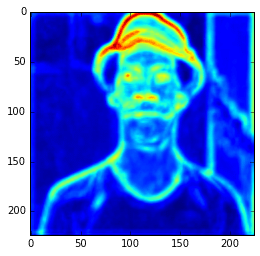
Ad you can see, those first hypercolumn activations are all looking like edge detectors, let’s see how these hypercolumns looks like for the layers 22 and 29:
layers_extract = [22, 29] hc = extract_hypercolumn(model, layers_extract, im) ave = np.average(hc.transpose(1, 2, 0), axis=2) plt.imshow(ave)
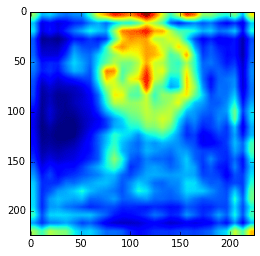
As we can see now, the features are really more abstract and semantically interesting but with spatial information a little fuzzy.
Remember that you can extract the hypercolumns using all the initial layers and also the final layers, including the FC layers. Here I’m extracting them separately to show how they differ in the visualization plots.
Simple hypercolumn pixel clustering
Now, you can do a lot of things, you can use these hypercolumns to classify pixels for some task, to do automatic pixel colorization, segmentation, etc. What I’m going to do here just as an experiment, is to use the hypercolumns (from the VGG-16 layers 3, 8, 15, 22, 29) and then cluster it using KMeans with 2 clusters:
m = hc.transpose(1,2,0).reshape(50176, -1) kmeans = cluster.KMeans(n_clusters=2, max_iter=300, n_jobs=5, precompute_distances=True) cluster_labels = kmeans .fit_predict(m) imcluster = np.zeros((224,224)) imcluster = imcluster.reshape((224*224,)) imcluster = cluster_labels plt.imshow(imcluster.reshape(224, 224), cmap="hot")
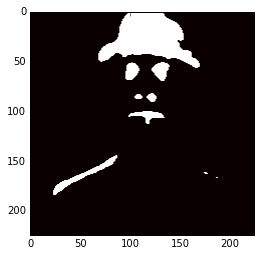
Now you can imagine how useful hypercolumns can be to tasks like keypoints extraction, segmentation, etc. It’s a very elegant, simple and useful concept.
I hope you liked it !
– Christian S. Perone
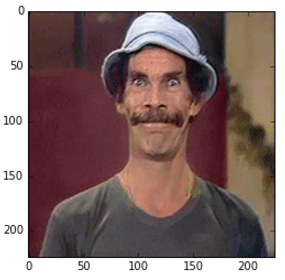
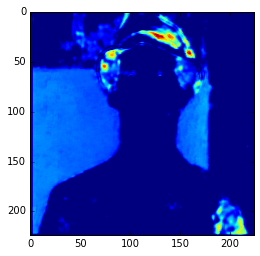
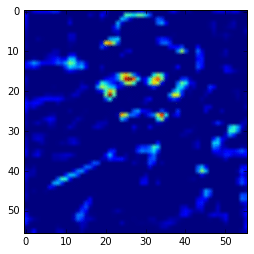

Thank you for this post! 🙂 A small error – missing ‘import’ in line ~11:
from keras.layers.convolutional import ZeroPadding2D
Thanks ! Fixed the error.
nice post!
nice post on hyper columns
Nice post!. If you want to update the code to make it runnable in the last version of keras you need to change “stride” with “strides” in the network definition.
Where do you use StandardScaler exactly?
It’s an unused import, I was trying DBSCAN and then I removed it due to some performance issues and I forgot to remove the StandardScaler. Thanks for pointing out.
Hi,
Ryan Dahl on Automatic Colorization mentioned hyercolumns didn’t work well. so he tried using Residual networks idea to use previous layers features.
Could you provide us with the code in theano how to do so?
Best
I love it. Great post. I did not know about hypercolumns. Will study more to apply on my research
great article, thank you
first, great post!
but got the weight file, copy/pasted your code, a few tiny plt display tweaks to write the images to disk vs popup displays…. everything looked a 99% match to your images.
however, the final image showed just a single roundish blob in the center of the head.
puzzled thru this a while trying various things but no luck, the small single blog remained, then noticed your comment “use the hypercolumns (from the VGG-16 layers 3, 8, 15,22, 29)”.
so as a final guess i changed the final layers code to this:
#layers_extract = [22, 29]
layers_extract = [3, 8, 15, 22, 29]
bingo, my final image looked exactly like yours!
it could’ve been something stupid somewhere else that i did by accident when copying the code but just in case somebody has a similar problem, thought i’d post my little solution to my particular issue.
Hi, AHayden
I just met the similar problem as you described. No matter I set layers_extract as [22, 29] or [3, 8, 15, 22, 29], the final image just showed the same `single blob’. My code is
layers_extract = [3, 8, 15, 22, 29]
hc = extract_hypercolumn(model, layers_extract, im)
m = hc.transpose(1,2,0).reshape(50176, -1)
….
I’m just wondering do you happen to know the reason? Thanks a lot!
This is awsome
Very good article and idea.
Please correct the following:
When defining the ConvNet instead of “stride” use “strides” otherwise it does not compile.
According to original paper the images were preprocessed by subtracting the mean of the training images from every channel. You need to do this when you use the pre-trained weights of VGG16 to recognise new images. No standard scaling needed in this case.
You’re right, I forgot to copy to the post the mean subtraction code. Thanks for pointing that.
It is interesting that the prediction was T-shirt, while the deeper layers had more semantic understanding of the face!!
I assume ImageNet doesn’t have a class of face, or man in the 1000 classes.. I might be wrong. Good post though 😉 ..
Hi,
Thanks for the nice tutorial. I currently have the following version of the code from the tutorial: https://www.dropbox.com/s/nlg78oyvkrj86v6/hypercolumn.py?dl=1
When I try to run the code, I get the following:
Using Theano backend.
Traceback (most recent call last):
File “hypercolumn.py”, line 85, in
get_feature = theano.function([model.layers[0].input], model.layers[3].output(train=False), allow_input_downcast=False)
TypeError: ‘TensorVariable’ object is not callable
Do you know how I can solve this error?
Thanks.
Hi Abder, what comes to my mind is that you are probably using a diferent version of Theano or Keras.
Just drop (train=False) and you’d be fine!
How can I use vgg model to extract feature from a tensor ( image is in the form of tensor).
very nicely written post.. kudos! 🙂
hi ,I use the Graph model.
like this,
model = graph()
model.add_input(name=’input0′,input_shape=())
model.add_node(Convolution2D(),name=’c1′,input=’input0′)
…….
And i want to see the output of the `c1`,Then
getFeatureMap = theano.function(model.inputs[‘input0’].input,model.nodes[‘c1’].get_output(train=False),
allow_input_downcast=True)
But it show me that
`TypeError: list indices must be integers, not str`
Do you give me some advices? Thanks.
Hey,
I realy like your work.
I am curently working on a a consept to solve some problems the searchwing.org team curently has. One of these concepts utilises openCV. There is a talk that covers there work here: https://www.youtube.com/watch?v=SCUCRwFs_Lg&t=29s . Unfortunaly i do not have any Experience with opencv. That’s why i wanted to ask you if would like to help me on that regard. Please contact me so that i can explain you my idea.
Greatings forom Germany
Axel Just
Great post! Might help me a lot for my thesis 🙂 I am working on a PixelNet which also uses hypercolumns! This helped me understand the concept very well! But I have write the code in MatConvNet!
Do you somehow have understood the concept of 2D LSTM (Long Short Term Memory)?
Thanks & Regards
Savan
Amazing man
Hi, Great post !
Q: why “layers_extract = [3, 8]” gets the first map from two conv layers ?
From VGG defined above, it looks like [3, 6] , gets them.
def VGG_16(weights_path=None):
model = Sequential()
model.add(ZeroPadding2D((1,1),input_shape=(3,224,224)))
model.add(Convolution2D(64, 3, 3, activation=’relu’))
model.add(ZeroPadding2D((1,1)))
model.add(Convolution2D(64, 3, 3, activation=’relu’))
model.add(MaxPooling2D((2,2), stride=(2,2)))
model.add(ZeroPadding2D((1,1)))
model.add(Convolution2D(128, 3, 3, activation=’relu’))
model.add(ZeroPadding2D((1,1)))
model.add(Convolution2D(128, 3, 3, activation=’relu’))
model.add(MaxPooling2D((2,2), stride=(2,2)))
def VGG_16(weights_path=None):
…
model.add(Convolution2D(64, 3, 3, activation=’relu’)) — 1
model.add(Convolution2D(64, 3, 3, activation=’relu’)) — 2
model.add(MaxPooling2D((2,2), stride=(2,2))) —3
model.add(Convolution2D(128, 3, 3, activation=’relu’)) — 4
model.add(Convolution2D(128, 3, 3, activation=’relu’)) — 5
model.add(MaxPooling2D((2,2), stride=(2,2))) — 6
I copy your code to reimplement it.
but the platform display some errors,can you help me ?
File “v16.py”, line 75, in VGG_16
model.load_weights(weights_path)
File “C:\Anaconda3\lib\site-packages\keras\models.py”, line 706, in load_weigh
ts
topology.load_weights_from_hdf5_group(f, layers)
File “C:\Anaconda3\lib\site-packages\keras\engine\topology.py”, line 2869, in
load_weights_from_hdf5_group
layer_names = [n.decode(‘utf8’) for n in f.attrs[‘layer_names’]]
File “h5py\_objects.pyx”, line 54, in h5py._objects.with_phil.wrapper (C:\aroo
t\work\h5py\_objects.c:2579)
File “h5py\_objects.pyx”, line 55, in h5py._objects.with_phil.wrapper (C:\aroo
t\work\h5py\_objects.c:2538)
File “C:\Anaconda3\lib\site-packages\h5py\_hl\attrs.py”, line 58, in __getitem
__
attr = h5a.open(self._id, self._e(name))
File “h5py\_objects.pyx”, line 54, in h5py._objects.with_phil.wrapper (C:\aroo
t\work\h5py\_objects.c:2579)
File “h5py\_objects.pyx”, line 55, in h5py._objects.with_phil.wrapper (C:\aroo
t\work\h5py\_objects.c:2538)
File “h5py\h5a.pyx”, line 77, in h5py.h5a.open (C:\aroot\work\h5py\h5a.c:2083)
KeyError: “Can’t open attribute (Can’t locate attribute: ‘layer_names’)”
Really good.. 🙂
get_feature = theano.function([model.layers[0].input], model.layers[3].get_output(train=False), allow_input_downcast=False)
AttributeError: ‘MaxPooling2D’ object has no attribute ‘get_output’
Whether I use the theano or the tensor flow backend, I get the same error. The source code of the class MaxPoolin2D confirms that there is no method or attribute called get_output which is used thrice in the code.
I am using the latest versions which I just upgraded using pip.
Can someone please help.
Hello Vijay, I’m facing the same problem, have you managed to solve it?
If you are using keras 2.x you should change get_output(train=False)
for output ,
Your code should look like this
get_feature = theano.function([model.layers[0].input], model.layers[3].output, allow_input_downcast=False)
Hello,
How do I use your algorithm to train a new datasete with two classes? I need to get new weights.
Thanks,
Gledson
Hi,
Could you please tell me how to combine extracted hypercolumn features with the input image pixels and feed it to a cnn network?
excelent , but i have a question , in keras isnt there a vgg16 only with declarate VGG16() by default? ,is necessary declarate all the weights and all the model, i want to pass from the paper the original code , and i dont know how..